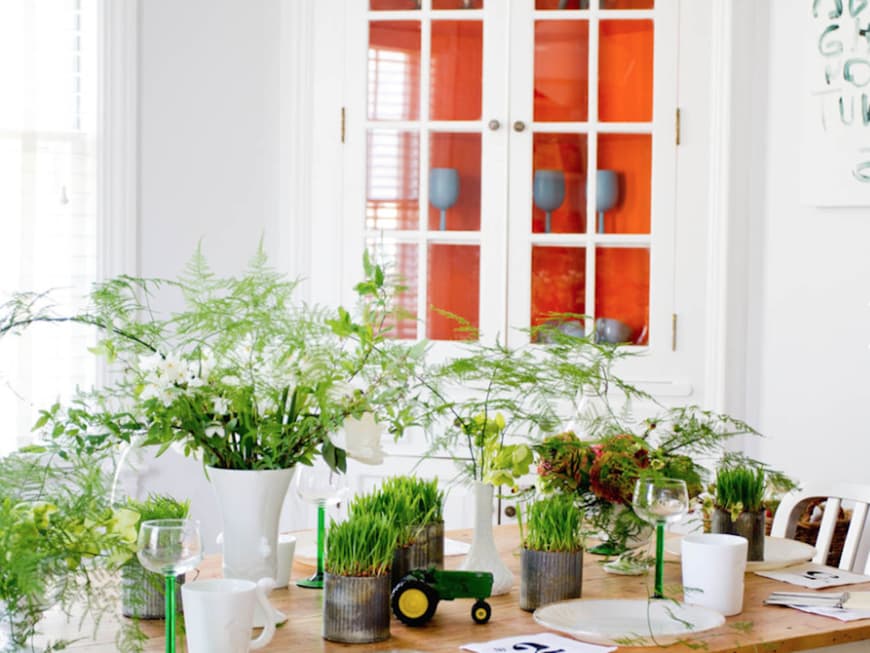
For this arrangement, Worlock focused on a green color scheme with a touch of pink. Among the plants used are ornamental asparagus, Christmas roses, peonies, and, for variety, some tin pots filled with grass.
Tools and materials
◦ Transparent florist's tape / florist's tape
◦ Scissors
◦ Sharp knife / cutter
◦ Permanent marker
◦ Tin cans
Plants and grasses
◦ Peonies
Christmas roses
◦ Ranunculus
(White) daffodils
◦ Grass
◦ Ornamental asparagus
Look in the crockery cupboard to see which pieces you could use. We opted for a selection of milky white opal glass vases and a vintage cream jug and sugar bowl.
1. start with the largest bouquet
Start with the largest vase and the peonies and buds. Hold the flowers against the vase to estimate the cutting height. To keep the flowers fresh while you arrange them, cut the stems at a steep angle and place the flowers in cold water.
Add more peonies until the bouquet is really lush. Also use stems with closed buds to create a natural, slightly asymmetrical look. Keep turning the vase to make sure the bouquet looks good from every angle. Finally, fill in the gaps with (white) daffodils.
2. arrange simply with narrow vases
For a narrow vase, it is best to start with a long-stemmed ornamental asparagus, the leaves of which you can simply let fall loosely over the edge of the vase. Next, add some Christmas roses.
To keep the Christmas roses fresh, cut their stems at a steep angle and place the flowers briefly in hot water before arranging them.
3. fill a sugar bowl with dogwood and ranunculus
Stick two strips of transparent floral tape crosswise over the opening of the box to hold the plants in place.
Start with ornamental asparagus as a base and place it in the four fields created by the taping.
Then add a few short dogwood branches to create volume and texture.
Complete the arrangement with ranunculus in green and pink, their stems shortened so that only the flowers are visible.
Fill in the last gaps with dogwood.
4. fill a milk jug with ornamental asparagus and Christmas roses
Start again with ornamental asparagus.
Add pieces of green Christmas roses. The wild arrangement creates a beautiful contrast in the overall concept.
"I don't usually follow a set plan with an ensemble like this," says Worlock. "I like to take inspiration from each individual container and play with the variations of plants, texture and shape to create something that is unique and beautiful."
5. plant spring grass in rustic tin cans
To add accents, Worlock used tin cans with pre-grown patches of grass (ask your local florist for these - alternatively, buy or grow cat grass in a cup).
Turn the patch of grass over so that the roots are facing upwards. Use a marker to trace the shape of the tin.
Use a sharp knife to cut along the marked line, through the roots and soil.
Carefully place the cut-out piece of grass in the tin. Use a knife to allow it to slide in. Water the grass daily to keep it fresh.
6. create the centerpiece
You are now ready to place everything on the table. Place the largest bouquet in the center of the table and the smaller ones at the ends.
Adjust the individual arrangements to each other, checking the balance from all angles. Allow the ornamental asparagus in all containers to blend in with the neighboring ones.
Stagger the tins of grass outwards, as you would with a garland.
7. cover the table
Use tableware that harmonizes with the color scheme. Worlock set the table with old gold-rimmed porcelain plates; she bought the glasses at a household clearance sale; the white cups were a gift from her sister.
Worlock inherited the cutlery from her grandparents and the napkins from Wisteria complete the table.
Before the meal, you can create temporary accents at the ends of the table by placing more tins planted with grass there. When it's time to sit down, simply remove them.
Add details that you like: A green toy tractor and white votive candle holders add a special, mischievous country touch.
To keep everything fresh for a long time, change the water daily and trim the ends of the flower stems.
Text: Houzz/Rikki Snyder
